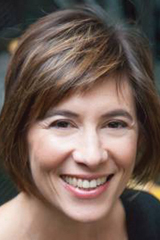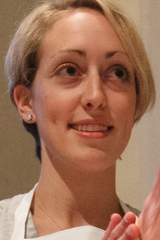lives
THREEPROFILES |
In this issue we visit three activists reinvigorating Jewish culture, practice, and experience to help open doors to even broader segments of the community. by LIAM HOARE |

“Knowing that Shabbat could in fact create an opportunity for young adults to engage with each other in a meaningful way gave a sense of urgency to this effort.” |
ALIZA KLINESetting the Table for Community“If Shabbat is so good, how come most people don’t do it?” Aliza Kline asked me. After all, she believes, Shabbat dinner affords an opportunity to create and deepen Jewish experience like few others. It contains multitudes: food and drink, ritual, friendship, community, and opportunities for intellectual conversation. It can be done anywhere, including and especially in people’s homes. It is a regular occurrence, thus offering ongoing engagement. And, critically, it doesn’t require institutional leadership. Therefore, as Founding Executive Director of OneTable, it has been Kline’s mission since 2014 to address this question and introduce (or reintroduce) Shabbat dinner to young, non-Orthodox, American Jewish adults. Launched in partnership with The Steinhardt Foundation for Jewish Life and The Paul E. Singer Foundation, OneTable is an online and in-person community whose focus is on helping American Jews in their 20s and 30s find, enjoy, and share Shabbat dinners. Its role is that of a facilitator. When your apartment doesn’t have a dining-room table or when hosting a dinner for eight or twelve on a Millennial’s salary appears daunting, there are a lot of potential barriers to putting together a Shabbat dinner. This is to say nothing of people’s self-doubts about their own knowledge and practice regarding Jewish ritual (though OneTable itself is non-prescriptive about this.) And, at a time when Millennials are known to be disproportionally affected by social isolation, to be addicted to technology, and to have higher levels of depression and anxiety, “knowing that Shabbat could in fact create an opportunity for young adults to engage with each other in a meaningful way gave a sense of urgency to this effort,” Kline said. (Today, whether the intention is to host or attend a dinner, the majority of people find OneTable on a peer-to-peer basis — through an introduction by a friend, for example.) To explain the process: once the online application is approved and the dinner date is set, OneTable makes eligible a variety of resources that can help make the Shabbat meal possible. First, there is one-on-one Shabbat coaching, with people who can help locate a venue, plan a menu, incorporate ritual (if desired), and choose conversation topics. Second, there are cooking classes mixed with Jewish learning. And third, a “nourishment credit” is provided to buy groceries, wine, and decorations. In its first six months, while it worked with existing social platforms designed to bring people together for meals in people’s homes and targeted certain sectors of the American Jewish community, OneTable provided 2,500 seats for Shabbat dinners. In 2015, that number grew to 10,000 seats; in 2016, 40,000; and when we spoke in late 2017, OneTable was on target for 70,000 seats. The goal for 2018 is at least 100,000 seats, which means that 60-70,000 Millennials will have participated in Shabbat dinners through OneTable since it started. Since 2014, OneTable has found that “there is a positive association in and of itself with Shabbat and to gather for Shabbat is articulated as one of the top motivations” for people wanting to host or attend a dinner, Kline said. There is also an emphasis on community, whether that means building new communities or supporting existing ones. “Knowing they’re going to see people that they care about is really a drive to come back to that dinner.” Some dinners are built around ideas of social justice and others emphasize a spiritual dimension. “Shabbat is a personal anchor in my life and really it always has been,” Kline — who is also the co-founder of the Mayyim Hayyim Living Waters Community Mikveh and Education Center in Newton, MA — told me. “I cannot recall a week when I didn’t mark it in some important and personal way. I move through the world at a high speed — talk fast, walk fast, make decisions quickly — and I need the obligation to slow down. I look forward to Shabbat and, as soon as it ends, I’m thinking about the next.” A graduate of New York University, Kline grew up in Colorado Springs, Colorado, “where my Jewishness was absolutely a defining factor in what separated my family from most other Coloradans.” It was in this environment that Shabbat dinner grew in importance for her. “My parents knew that what we did in our home was going to have a huge influence on my love for Jewish practices.” Now living in Brooklyn with her husband and three daughters — and her parents nearby — Shabbat dinner continues to center Kline’s life. Her menu remains largely the same week-to-week, with certain dishes rotating in and out. She finds a certain joy in challah, especially when made by her mother. In light of the white tablecloths and china place settings, the meal is ostensibly traditional, but certain aspects have been altered, including reciting the blessings in the feminine for the benefit of her daughters. Kline’s professional life has been in the realm of opening up Jewish practice and ritual “in a way that has integrity and inclusiveness.” Today that extends to Shabbat dinner. “We live in such a fast-paced world that we can miss an important moment, and rituals give us an opportunity to slow down and pay attention to the moment, which leads to a happier and healthier life.” ■ |
 “I really wanted a place where we could talk about difficult issues on my campus with other Jewish students. When I started, I couldn’t bake a challah to save my life.” |
CARLY ZIMMERMANBraiding Memory With Social JusticeCarly Zimmerman first heard about Challah for Hunger in 2007, when she was a student at the University of Pittsburgh. The fundraising organization — which bakes and sells challah and donates the profits to social-justice causes — was three years old at the time and its principal effort was aiding the victims of the War in Darfur — a cause Zimmerman shared. Seeing its potential, she began the eighth Challah for Hunger chapter, and with it, her involvement with a non-profit that saw her become its CEO in 2013. “I really wanted a place where we could talk about difficult issues on my campus with other Jewish students,” Zimmerman told me. The University of Pittsburgh, where she studied history and political science, was neither political nor apolitical, with an untapped potential for activism. “When I started, I couldn’t bake a challah to save my life. We actually bought the dough the first time we did it, [but] I saw it was a nice way to get people to come through the door. It was so much easier, standing around the kitchen braiding challah, to start to have those conversations that otherwise would have been really challenging about what was happening in Darfur.” Challah for Hunger was founded in 2004 by Eli Winkelman, who was at the time a student at Scripps College in Claremont, California. At home, she baked challah with her mother and sister and, feeling homesick at college, she started to teach friends how to make it. The circle of people who wanted to bake with her grew and out of this interest came the notion of using and selling challah to raise money for charitable causes. In the beginning, fundraising was associated with the conflict in Darfur, and Winkelman partnered with American Jewish World Service in that effort. Out of a single group of students at Scripps College grew a multi-chapter organization spread across more than 80 college campuses in the United States and overseas. Its structure has evolved: the group incorporated as a 501(c)3 in 2009; its headquarters moved from Austin to Philadelphia, where Zimmerman lives today with her family; and it changed its partner organization to MAZON: A Jewish Response to Hunger. But it remains student-run and student-led at the campus level, leaving students responsible for fundraising and event planning, with Challah for Hunger centrally assisting with practical resources and peer mentoring. Another thing that has changed is the focus of Challah for Hunger’s giving. Since 2004, it has moved away from international crisis zones like Darfur to social-justice issues in the United States, including and especially hunger on college campuses. “The students were starting to get interested in what local partners were doing on the ground and how they could support them,” Zimmerman said, emphasizing that the shift to food insecurity and disaster relief was also student-driven. “I think our students have become aware over the past couple of years that there’s a lot of work to be done at home as well,” Zimmerman said. Though not a new phenomenon by any means, especially at community colleges, food insecurity has recently become an issue at traditional state and private colleges as well. The cost of college in general; scholarships for low-income students not covering the full or true cost of the college experience, including food, books, and transportation; and issues surrounding the eligibility of college students for SNAP have all contributed to this. “It became very difficult to think about long-term change in Darfur because the American government was no longer thinking or focusing on it” after 2008. “One of the things we learned is that in order for these college students to get a fuller picture, we not only need to rethink what our causes are but we need to think about how they engage with them every day,” Zimmerman said, which is what led Challah for Hunger to launch the Campus Hunger Project, which is seeking to find a long-term solution with an educational campaign and national research project. Zimmerman, who previously worked at Hillel, believes Challah for Hunger’s success as a fundraising initiative rests in the connection between Jewish memory and food — that when Jewish students come into the kitchen and braid challah together, they make the connection between that experience and earlier memories of baking bread in their communities or with family. This, Zimmerman believes, allows people to open up, discuss their own experiences, and then relate them to contemporary issues and those who live vulnerable lives today, both at home and around the world. “Somebody recently said to me, ‘There is nothing more Jewish than what Challah for Hunger does,’” Zimmerman concluded. “Our work incorporates some significant Jewish values: not only ideas of community and bettering the world but the notion of Shabbat. For a lot of our students, the time that they’re in the kitchen, learning together, they come because it’s a marker in their week that’s different from classes or social obligations. It’s their social justice Shabbat. It provides a moment to recharge, to stop and reflect, to rest and set intentions with social justice in mind.” ■ |

“Leonard Cohen and bagels are amazing, but I wanted people to reinvest in the culture of this community, to help enrich their own identities and create new culture of the city in general.” |
ZEV MOSESReinventing a People’s MuseumAmuseum’s role is to interpret and explain histories and cultures, Zev Moses, Executive Director of the Museum of Jewish Montreal (MJM), tells me. And Jewish Montreal, he says, has “a very particular history, culture, and experience that is worth exploring both for the community itself and also for people — and this is a big part of what we do — explaining ourselves to the broader society around us, in Montreal, Quebec, and Canada.” Moses founded MJM in 2010, at a time when, while the Jewish community itself was aware of its own uniqueness, the story of Jewish Montreal was being diluted or distilled down to a few pieces that everyone knew about: Leonard Cohen, bagels, and Montreal smoked meat. Moses’ fear was that the richness of Jewish Montreal’s society and culture was being lost, not only amid this process of distillation but as those who could remember the earlier immigrant experience passed on. Jewish Montreal “is a weird mix of experiences from North America and Europe,” said Moses, who has lived in the city from the time he was young. “In some ways, Montreal’s Jewish history is quite similar to New York’s, Philadelphia’s, or Chicago’s: Ashkenazi, Yiddish-speaking immigrants come across in the early 20th century and have a working-class immigrant experience where they work their way up.” But it differs in two main ways, Moses adds. “First, the unique social context of Quebec and Montreal in particular: at the time, being a kind of bi-national city, French and Catholic and English and Protestant. There was no way to fully fit in if you were Jewish” both socially and legally, to the extent that city institutions were denominational. “The Jewish community had to fend and create everything for itself.” It became an institutionally and culturally rich community, somewhat separate from the rest of society until the 1960s. “The other big difference has been the different immigrant groups that have come since the 1950s and 1960s, in particular Moroccan Sephardic Jews but also Jews from other Mizrahi areas as well, who have maintained their identity separate from the Ashkenazi community to some degree, in a way that you don’t really see across North America. “Leonard Cohen and bagels are amazing,” Moses said, “but I wanted people to reinvest in the culture of this community, to help enrich their own identities and create new culture of the city in general.” The museum was envisaged, and acts today, as “an entry point into learning more about our community’s history and culture” — both for members of Montreal’s Jewish community and tourists passing through the city. In 2010, MJM began online as a mapping project, drawing on Moses’ interests and professional background, having studied city planning at the University of Pennsylvania and worked as a real estate consultant. The intent was to find and place people and events, thus creating a map of Montreal’s Jewish history which could be publicly accessible. At the same time, the established Jewish community was looking to grant additional resources to culture and identity building, opening up a source of funding for Moses’ project. After a couple of years, the mapping project evolved into walking tours, which were running daily by the summers of 2013 and 2014. In 2014 the museum staged pop-up exhibitions around Montreal for the first time. In this sense, MJM operated as a museum without walls, a concept that’s been embraced by Jewish institutions lacking a permanent physical space such as the JCCs in Charleston, South Carolina and (until recently) Warsaw, Poland. But the growth of the museum without walls was, paradoxically, what led Moses and his team to pursue the procurement of a permanent space. Without one, they found it more difficult to build a community around MJM. Moses also had trouble selling the concept of the museum to donors simply because they couldn’t visit it. In June 2016, MJM opened up a storefront for their museum in a former schmatta factory. “It’s not a very large space,” Moses said, “but it’s in the historic Jewish neighborhood so it feels authentic for people visiting, people who have connections to the old neighborhood.” It doesn’t look like a traditional museum. There’s very little gallery space. MJM today offers four walking tours and a food tour of Jewish Montreal, as this continues to be the main way visitors experience the museum. The storefront serves as the point of entry, as an event space, and, in the daytime, as a café and boutique. MJM’s next step, in the mold of the Tenement Museum in New York, is to offer tours of indoor spaces. Sometimes it makes sense to go for the grand, all-encompassing exhibition space in the landmark building: the Museum of the History of Polish Jews in Warsaw, the Jewish Museum Berlin, or the United States Holocaust Memorial Museum in Washington, DC. But that model can have constraints, Moses said — “it can feel manufactured to people.” There is more than one way to tell a community’s history, and with MJM, “we’re constantly testing new concepts, seeing what works and what doesn’t, finding audiences for things,” Moses added. “We’re trying to slowly change people’s concepts of what a museum can be and should be. We’re becoming an essential part of the cultural landscape of the city.” ■ |
Liam Hoare is a contributor to Moment and writes frequently for The Forward, Tablet, and Slate. He is based in the United Kingdom and is a graduate of University College London’s School of Slavonic and East European Studies.
| PREVIOUS ARTICLE | NEXT ARTICLE |